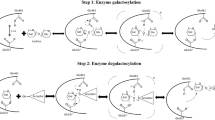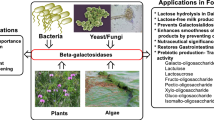Abstract
The gene encoding a glycoside hydrolase family 43 β-xylosidase (GbtXyl43A) from the thermophilic bacterium Geobacillus thermoleovorans strain IT-08 was synthesized and cloned with a C-terminal His-tag into a pET29b expression vector. The recombinant gene product termed GbtXyl43A was expressed in Escherichia coli and purified to apparent homogeneity. Michaelis–Menten kinetic parameters were obtained for the artificial substrates p-nitrophenyl-β-d-xylopyranose (4NPX) and p-nitrophenyl-α-l-arabinofuranose (4NPA), and it was found that the ratio k cat/K m 4NPA/k cat/K m 4NPX was ∼7, indicting greater catalytic efficiency for 4NP hydrolysis from the arabinofuranose aglycon moiety. Substrate inhibition was observed for the substrates 4-methylumbelliferyl xylopyranoside (muX) and the arabinofuranoside cogener (muA), and the ratio k cat/K m muA/k cat/K m muX was ∼5. The enzyme was competitively inhibited by monosaccharides, with an arabinose K i of 6.8 ± 0.62 mM and xylose K i of 76 ± 8.5 mM. The pH maxima was 5.0, and the enzyme was not thermally stable above 54 °C, with a t 1/2 of 35 min at 57.5 °C. GbtXyl43A showed a broad substrate specificity for hydrolysis of xylooligosaccharides up to the highest degree of polymerization tested (xylopentaose), and also released xylose from birch and beechwood arabinoxylan.



Similar content being viewed by others
References
Biely, P. (2003). In J. R. Whitaker, A. G. J. Voragen, & D. W. S. Wong (Eds.), Handbook of food enzymology pp. 879–915. New York: Marcel Dekker.
Saha, B. C. (2003). Journal of Industrial Microbiology & Biotechnology, 30, 279–291. doi:10.1007/s10295-003-0049-x.
Shallom, D., & Shoham, Y. (2003). Current Opinion in Microbiology, 6, 219–228. doi:10.1016/S1369-5274(03)00056-0.
Jordan, D. B., & Li, X. -L. (2007). Biochimica et Biophysica Acta, 1774, 1192–1198.
Mai, V., Wiegel, J., & Lorenz, W. W. (2000). Gene, 247, 137–143. doi:10.1016/S0378-1119(00)00106-2.
Lee, R. C., Hrmova, M., Burton, R. A., Lahnstein, J., & Fincher, G. B. (2003). The Journal of Biological Chemistry, 278, 5377–5387. doi:10.1074/jbc.M210627200.
Haki, G. D., & Rakshit, S. K. (2003). Bioresource Technology, 89, 17–34. doi:10.1016/S0960-8524(03)00033-6.
Sunna, A., Prowe, S. G., Stoffregen, T., & Antranikan, G. (1997). FEMS Microbiology Letters, 148, 209–216. doi:10.1111/j.1574-6968.1997.tb10290.x.
Cho, A.-R., Yoo, S.-K., & Kim, E.-J. (2000). FEMS Microbiology Letters, 186, 235–238. doi:10.1111/j.1574-6968.2000.tb09110.x.
Puspaningsiha, N.N.T. (2004). PhD thesis, Bogor Agricultural University, Indonesia.
Rohman, A., Oosterwijk, N. V., Kralj, S., Dijkhuizen, L., Dijkstrab, B. W., & Puspaningsiha, N. N. T. (2007). Acta Crystallographica, F63, 932–935.
Wagschal, K., Franqui-Espiet, D., Lee, C. C., Robertson, G. H., & Wong, D. W. S. (2005). Applied and Environmental Microbiology, 71, 5318–5323. doi:10.1128/AEM.71.9.5318-5323.2005.
Tsujibo, H., Kosaka, M., Ikenishi, S., Sato, T., Katsushiro, M., & Inamori, Y. (2004). Journal of Bacteriology, 186, 1029–1037. doi:10.1128/JB.186.4.1029-1037.2004.
Shulami, S., Gat, O., Sonenshein, A. L., & Shoham, Y. (1999). Journal of Bacteriology, 181, 3695–3704.
Coutinho, P. M., & Henrissat, B. (1999). In H. J. Gilbert, et al. (Ed.), Recent Advances in carbohydrate bioengineering pp. 3–12. Cambridge: The Royal Society of Chemistry, Cambridge.
Takami, H., Takaki, Y., & Uchiyama, I. (2002). Nucleic Acids Research, 30, 3927–3935. doi:10.1093/nar/gkf526.
Wagschal, K., Franqui-Espiet, D., Lee, C. C., Kibblewhite-Accinelli, R. E., Robertson, G. H., & Wong, D. W. S. (2007). Enzyme and Microbial Technology, 40, 747–753. doi:10.1016/j.enzmictec.2006.06.007.
Wagschal, K., Heng, C., Lee, C. C., & Wong, D. W. S. (2008). Applied Microbiology and Biotechnology. doi:10.1007/s00253-008-1662-4.
Pitson, S. M., Voragen, A. G. J., & Beldman, G. (1996). FEBS Letters, 398, 7–11. doi:10.1016/S0014-5793(96)01153-2.
Braun, C., Meinke, A., Ziser, L., & Withers, S. G. (1993). Analytical Biochemistry, 212, 259–262. doi:10.1006/abio.1993.1320.
Kersters-Hilderson, H., Claeyssens, M., Doorslaer, E. V., & Bruyne, C. K. D. (1976). Carbohydrate Research, 47, 269–273. doi:10.1016/S0008-6215(00)84192-0.
Koshland, D. E. (1953). Biological Reviews of the Cambridge Philosophical Society, 28, 416–436. doi:10.1111/j.1469-185X.1953.tb01386.x.
Ly, H. D., & Withers, S. G. (1999). Annual Review of Biochemistry, 68, 487–522. doi:10.1146/annurev.biochem.68.1.487.
Shallom, D., Leon, M., Bravman, T., Ben-David, A., Zaide, G., Belakhov, V., et al. (2005). Biochemistry, 44, 387–397. doi:10.1021/bi048059w.
Brüx, C., Ben-David, A., Shallom-Shezifi, D., Leon, M., Niefind, K., Shoham, G., et al. (2006). Journal of Molecular Biology, 359, 97–109. doi:10.1016/j.jmb.2006.03.005.
Jordan, D. B., Li, X.-L., Dunlap, C. A., Whitehead, T. R., & Cotta, M. A. (2007). Applied Biochemistry and Biotechnology, 141, 51–76. doi:10.1007/s12010-007-9210-8.
Malet, C., & Planas, A. (1997). Biochemistry, 36, 13838–13848. doi:10.1021/bi9711341.
Quiocho, F. A. (1989). Pure and Applied Chemistry, 61, 1293–1306. doi:10.1351/pac198961071293.
Roey, P. V., & Salerno, J. M. (1988). Acta Crystallographica, C44, 865–867.
Jordan, D. B., & Braker, J. D. (2007). Archives of Biochemistry and Biophysics, 465, 231–246. doi:10.1016/j.abb.2007.05.016.
Davies, G. J., Wilson, K. S., & Henrissat, B. (1997). The Biochemical Journal, 321, 557–559.
Timell, T. (1964). Advances in Carbohydrate Chemistry and Biochemistry, 19, 247–299.
Acknowledgements
Reference to a company and/or products is for purposes of information and does not imply approval or recommendation of the product to the exclusion of others that may also be suitable. All programs and services of the U.S. Department of Agriculture are offered on a nondiscriminatory basis without regard to race, color, national origin, religion, sex, age, marital status, or handicap.
Author information
Authors and Affiliations
Corresponding author
Rights and permissions
About this article
Cite this article
Wagschal, K., Heng, C., Lee, C.C. et al. Purification and Characterization of a Glycoside Hydrolase Family 43 β-xylosidase from Geobacillus thermoleovorans IT-08. Appl Biochem Biotechnol 155, 1–10 (2009). https://doi.org/10.1007/s12010-008-8362-5
Received:
Accepted:
Published:
Issue Date:
DOI: https://doi.org/10.1007/s12010-008-8362-5




